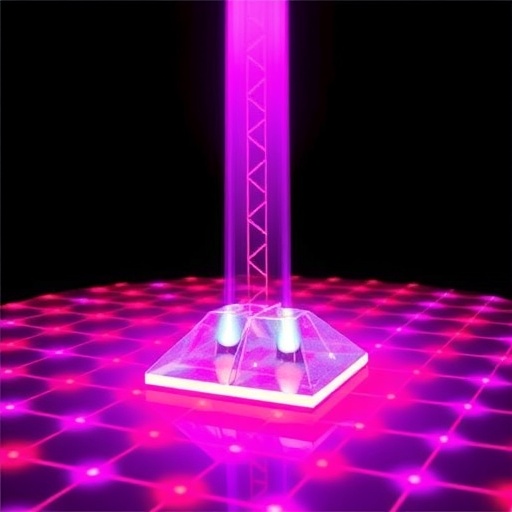In a groundbreaking advancement poised to reshape the future of quantum technology, researchers have uncovered the fundamental mechanism enabling superfluorescence at room temperature within hybrid perovskite materials. Published in Nature, this study delineates the intricate processes and material conditions that make possible this exotic quantum effect, which previously necessitated ultra-cold cryogenic environments. Such high-temperature macroscopic quantum coherence is a monumental leap forward, potentially ushering in a new era where devices like quantum computers operate without the burdensome need for extreme cooling.
Superfluorescence, a collective quantum phenomenon where groups of excited particles emit light in a coherent burst, shares kinship with other exotic quantum phases such as superconductivity and superfluidity. These phenomena arise when numerous quantum particles synchronize their behavior, collectively acting as a single coherent entity that transcends the limitations of individual particles. Typically confined to low-temperature regimes to avoid thermal disturbances, achieving such states at ambient conditions has long eluded scientists. Thermal noise, a formidable adversary, disrupts the delicate synchronization necessary for these macroscopic quantum phase transitions.
The research team, spearheaded by Kenan Gundogdu at North Carolina State University and comprising collaborators from Duke University, Boston University, and the Institut Polytechnique de Paris, has elucidated how certain hybrid perovskites overcome thermal noise to sustain these phase transitions. Central to their discovery is the role of polaronic quasiparticles—entities formed when electrons become strongly coupled to lattice distortions within the crystal structure. These large polarons act as insulating shields, protecting the quantum dipoles responsible for superfluorescence from thermal agitation.
.adsslot_K7lRQI4raJ{ width:728px !important; height:90px !important; }
@media (max-width:1199px) { .adsslot_K7lRQI4raJ{ width:468px !important; height:60px !important; } }
@media (max-width:767px) { .adsslot_K7lRQI4raJ{ width:320px !important; height:50px !important; } }
ADVERTISEMENT
A pivotal insight from this study is the observation of soliton formations—coherent, self-reinforcing wave packets—arising from the synchronization of polarons under laser excitation. Gundogdu analogizes the material’s atomic lattice to a taut fabric, with excitons represented as balls that deform this fabric locally. When these distortions order themselves collectively, forming solitons, the system exhibits a macroscopic quantum coherence capable of suppressing disruptive thermal fluctuations. Experiments directly captured the transition of polaron populations from incoherent, disordered phases to ordered, coherent soliton states, marking one of the first direct observations of macroscopic quantum state formation at elevated temperatures.
The soliton formation hinges on exceeding a critical density of excited polarons, beyond which the system spontaneously organizes into these coherent units. Through the work of Ph.D. student Mustafa Türe and postdoctoral researcher Melike Biliroglu, the team demonstrated both theoretically and experimentally that below this density threshold, polarons remain free and uncorrelated; above it, collective synchronization manifests as solitons. This transition—a hallmark of quantum phase phenomena—effectively creates a resilient macroscopic quantum entity in the presence of thermal noise.
Complementing the experimental findings, collaborators at Duke University and the Institut Polytechnique de Paris contributed sophisticated lattice dynamics simulations. These calculations illuminated how lattice oscillations, which ordinarily mediate thermal dephasing, are effectively dampened by soliton formation. The theoretical models confirm that exciton-lattice interactions intertwine electronic and structural degrees of freedom, fostering a new, entangled polaronic state that endures at high temperatures, thus facilitating superfluorescence.
This integrated approach combining high-resolution experimentation and rigorous theoretical modeling provides unprecedented clarity on the interplay between electron-lattice coupling and quantum coherence. Previously, the field grappled with gaps in understanding which material attributes reliably support high-temperature macroscopic quantum states. Now, the detailed phase transition map uncovered here offers blueprints for engineering novel quantum materials that maintain coherence without cryogenic cooling, dramatically expanding their applicability.
The implications for quantum technology are profound. Quantum communication, cryptography, sensing, and computation—fields currently constrained by the demanding infrastructure of ultra-low temperatures—stand to benefit immensely. By harnessing these soliton-mediated quantum states, future devices could operate under ambient conditions, simplifying design, reducing costs, and accelerating deployment. Franky So, co-author and NC State materials science distinguished professor, highlights that this breakthrough transforms theoretical possibilities into practical guidelines for next-generation quantum material innovation.
The experimental strategy involved exciting a lead-halide perovskite sample with ultrafast laser pulses, provoking large polaron formations. Subsequent optical measurements tracked intensity fluctuations in the macroscopic polarization, revealing the hallmark signs of superfluorescence emerging synchronously with polaron synchronization. These observations confirm that the transient excitonic recombination dynamics are intimately linked to the collective ordering of polarons into a coherent extended state.
This landmark study, supported by the U.S. Department of Energy Office of Science, exemplifies the power of interdisciplinary collaboration combining experimental physics, theoretical modeling, and materials engineering. The synergy among the involved institutions and international partners underscores the global nature of addressing complex quantum technological challenges. As the field advances, these insights lay a firm foundation upon which to build devices that unlock quantum functionalities previously thought accessible only under cryogenic conditions.
The discovery of soliton-driven superfluorescence in hybrid perovskites is more than a scientific milestone; it signals a paradigm shift in how materials can be designed and manipulated to support resilient macroscopic quantum states. By decoding the mechanisms that enable coherence amidst thermal noise, the research community can now embark on crafting tailored quantum materials optimized for ambient operation. This will likely accelerate the advent of practical quantum information technologies, bringing the quantum revolution closer to everyday reality.
Subject of Research: Not applicable
Article Title: Unconventional solitonic high-temperature superfluorescence from perovskites
News Publication Date: 28-May-2025
Web References: 10.1038/s41586-025-09030-x
References: Gundogdu et al., “Spontaneous Polaron Synchronization Leads to High-Temperature Perovskite Superfluorescence,” Nature, May 28, 2025.
Keywords
Superfluorescence, hybrid perovskites, polaron synchronization, solitons, macroscopic quantum coherence, high-temperature quantum phenomena, exciton-lattice interactions, quantum phase transitions, room temperature quantum effects, condensed matter physics, quantum information technology, thermal noise suppression
Tags: advancements in superfluorescence researchcollective quantum phenomenahigh-temperature quantum materialshybrid perovskite materialsKenan Gundogdu quantum studymacroscopic quantum coherencequantum computing without coolingQuantum Phase Transitionsroom temperature quantum technologySolitonic superfluorescencesynchronization of quantum particlesthermal noise in quantum systems





